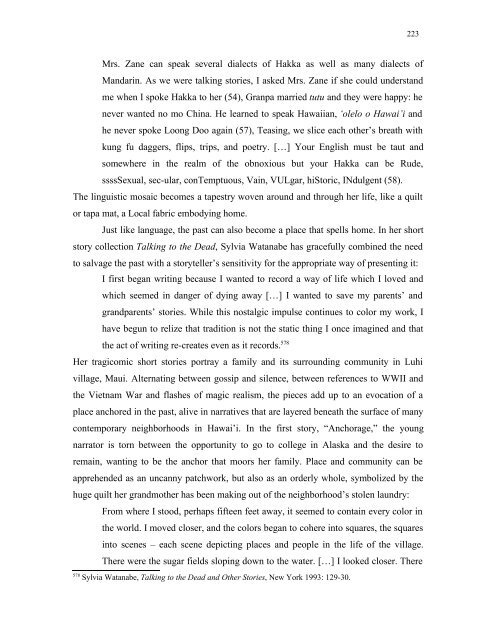A Paradise Lost - KOPS - Universität Konstanz
A Paradise Lost - KOPS - Universität Konstanz
A Paradise Lost - KOPS - Universität Konstanz
Create successful ePaper yourself
Turn your PDF publications into a flip-book with our unique Google optimized e-Paper software.
Mrs. Zane can speak several dialects of Hakka as well as many dialects of<br />
Mandarin. As we were talking stories, I asked Mrs. Zane if she could understand<br />
me when I spoke Hakka to her (54), Granpa married tutu and they were happy: he<br />
never wanted no mo China. He learned to speak Hawaiian, ‘olelo o Hawai’i and<br />
he never spoke Loong Doo again (57), Teasing, we slice each other’s breath with<br />
kung fu daggers, flips, trips, and poetry. […] Your English must be taut and<br />
somewhere in the realm of the obnoxious but your Hakka can be Rude,<br />
ssssSexual, sec-ular, conTemptuous, Vain, VULgar, hiStoric, INdulgent (58).<br />
The linguistic mosaic becomes a tapestry woven around and through her life, like a quilt<br />
or tapa mat, a Local fabric embodying home.<br />
Just like language, the past can also become a place that spells home. In her short<br />
story collection Talking to the Dead, Sylvia Watanabe has gracefully combined the need<br />
to salvage the past with a storyteller’s sensitivity for the appropriate way of presenting it:<br />
I first began writing because I wanted to record a way of life which I loved and<br />
which seemed in danger of dying away […] I wanted to save my parents’ and<br />
grandparents’ stories. While this nostalgic impulse continues to color my work, I<br />
have begun to relize that tradition is not the static thing I once imagined and that<br />
the act of writing re-creates even as it records. 578<br />
Her tragicomic short stories portray a family and its surrounding community in Luhi<br />
village, Maui. Alternating between gossip and silence, between references to WWII and<br />
the Vietnam War and flashes of magic realism, the pieces add up to an evocation of a<br />
place anchored in the past, alive in narratives that are layered beneath the surface of many<br />
contemporary neighborhoods in Hawai’i. In the first story, “Anchorage,” the young<br />
narrator is torn between the opportunity to go to college in Alaska and the desire to<br />
remain, wanting to be the anchor that moors her family. Place and community can be<br />
apprehended as an uncanny patchwork, but also as an orderly whole, symbolized by the<br />
huge quilt her grandmother has been making out of the neighborhood’s stolen laundry:<br />
From where I stood, perhaps fifteen feet away, it seemed to contain every color in<br />
the world. I moved closer, and the colors began to cohere into squares, the squares<br />
into scenes – each scene depicting places and people in the life of the village.<br />
There were the sugar fields sloping down to the water. […] I looked closer. There<br />
578 Sylvia Watanabe, Talking to the Dead and Other Stories, New York 1993: 129-30.<br />
223

















